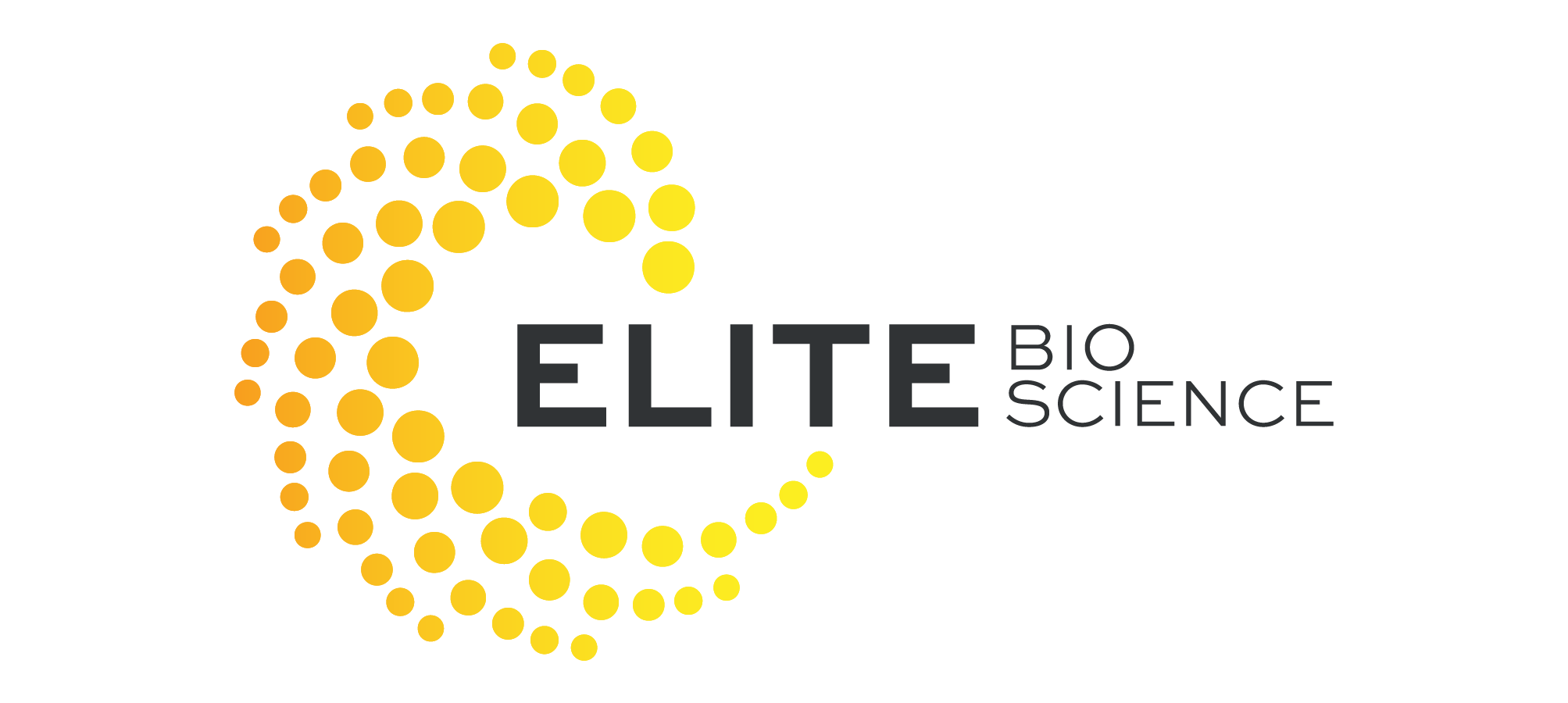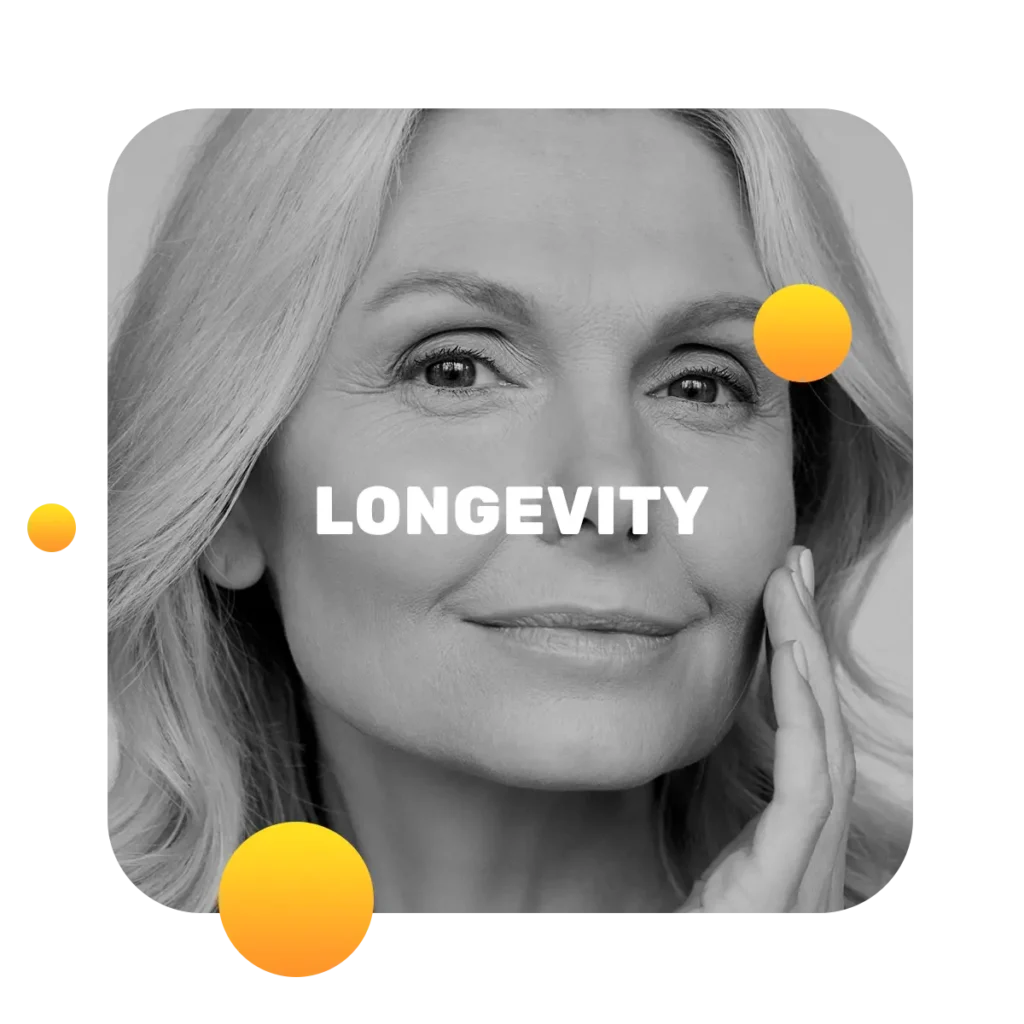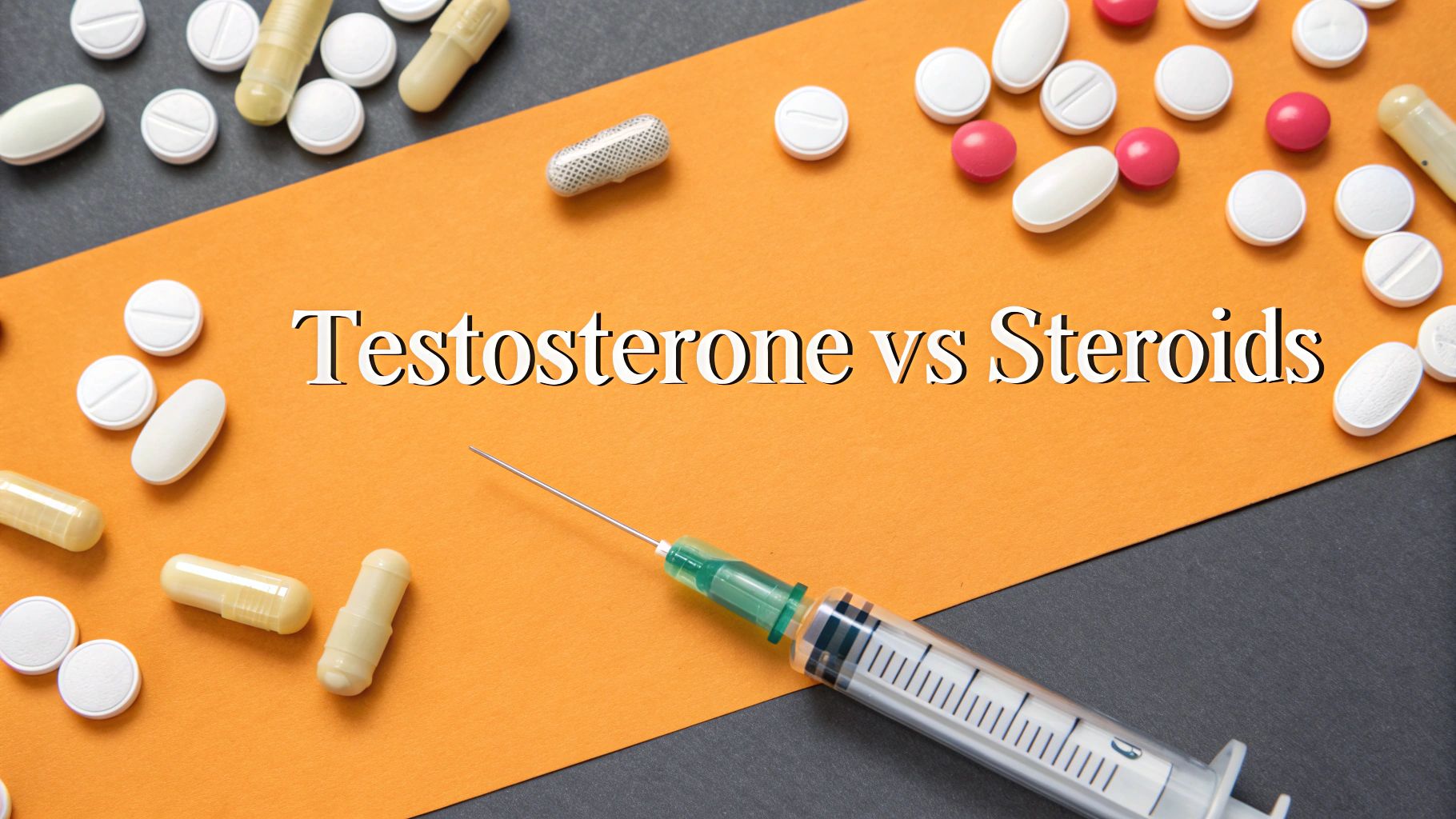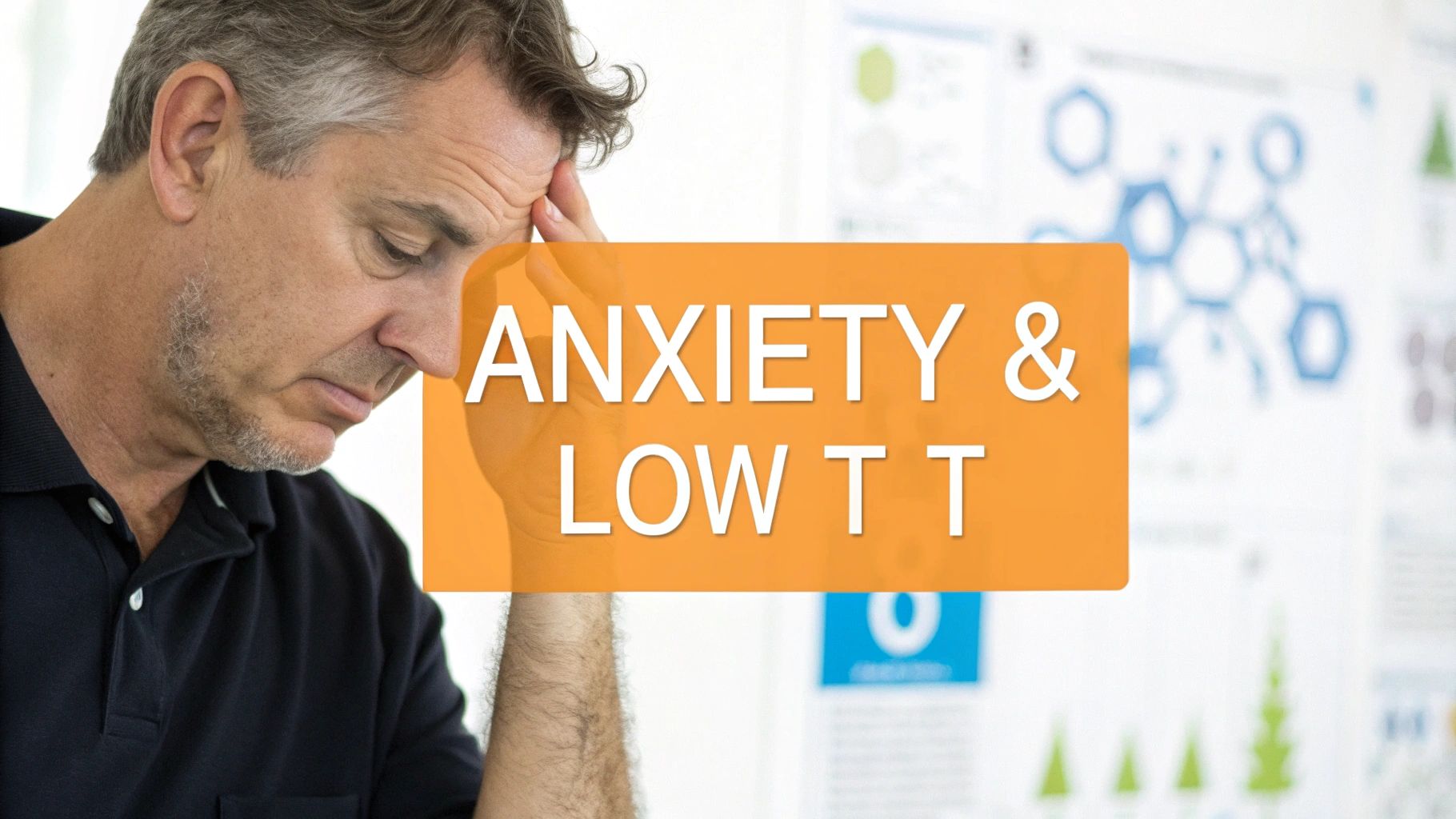Telltale Signs of Low Estrogen to Look Out For
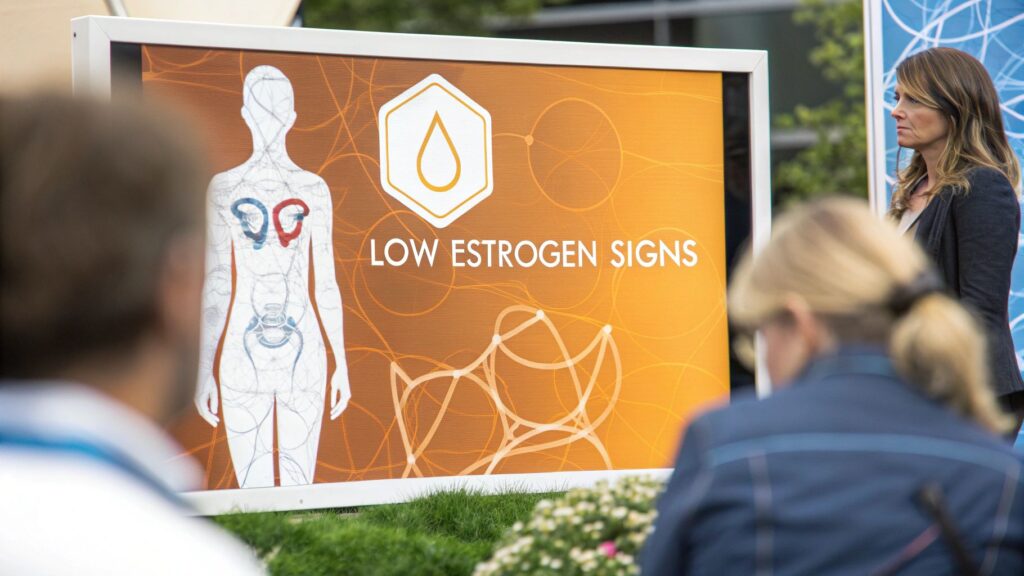
The most obvious signs that your estrogen is low tend to show up in how you feel, both physically and emotionally. We’re talking about things like hot flashes, night sweats, mood swings, and a deep-seated fatigue that coffee just can’t seem to fix.
These symptoms pop up when your body's main female hormone starts to decline, throwing everything from your internal thermostat to your brain chemistry out of whack. To figure out why you might be feeling so "off," the first step is understanding what estrogen actually does.
What Is Estrogen and Why It Matters for Your Health
Think of estrogen as your body's master conductor, directing a whole symphony of essential functions that keep you feeling your best. It’s so much more than just a reproductive hormone—it’s a critical player in regulating your mood, energy levels, bone density, and even the health and elasticity of your skin. When its levels are where they should be, that symphony plays in perfect harmony.
But when estrogen levels dip, the music starts to get disjointed. This is a totally natural part of perimenopause and menopause, but it can also happen because of other health issues. This hormonal slide is what kicks off the cascade of symptoms so many women know all too well.
The Three Main Types of Estrogen
Your body actually makes three different kinds of estrogen, and each one takes the lead during different stages of your life:
- Estrone (E1): This is the primary form of estrogen your body produces after menopause. It's a weaker version, but it becomes the main player once the other types fade into the background.
- Estradiol (E2): This is the powerhouse. As the strongest and most dominant form during your reproductive years, estradiol is what runs the show for your menstrual cycle and supports a healthy pregnancy.
- Estriol (E3): Produced mainly during pregnancy, estriol helps the uterus grow and gets your body ready for childbirth.
Understanding these differences is key. The classic signs of low estrogen are almost always tied to the decline of estradiol, which has the most far-reaching effects on your body, influencing everything from your brain to your bones.
Once you see how this powerful hormone touches so many different systems, it's easier to understand why a drop can cause such a wide and disruptive range of symptoms. This foundational knowledge is crucial when you start thinking about how to handle these changes.
For those looking at their options, learning more about treatments like hormone replacement therapy can help you see a clearer path forward. By understanding the "why" behind what you're feeling, you can better navigate the journey toward restoring your balance and feeling like yourself again.
The Most Common Physical Signs of Low Estrogen

When your estrogen levels start to drop, your body has a way of sending out some pretty clear signals. These aren’t just vague feelings of being a bit "off"—they are real, physical changes you can see and feel. Think of them as a barometer for your internal hormonal climate. Learning to read these signs is the first step toward figuring out what's going on and getting back to feeling like yourself.
The most famous of these signals are vasomotor symptoms, which you probably know as hot flashes and night sweats. These sudden, intense waves of heat can make it feel like your internal thermostat has gone completely haywire. One minute you’re perfectly comfortable, and the next you’re flushed and sweating. It’s disruptive, to say the least, and can make a good night's sleep feel like a distant memory.
So, what's happening? Estrogen plays a key role in regulating your hypothalamus, the part of your brain that acts as your body's temperature control center. When estrogen is low, the hypothalamus gets hypersensitive to even tiny temperature shifts, causing it to overreact and trigger a "flash" to cool you down.
From Hot Flashes to Skin Changes
While hot flashes tend to get all the attention, the physical signs of low estrogen reach far beyond your internal thermostat. Estrogen is a huge player in maintaining the health and resilience of your skin, hair, and nails, primarily by supporting collagen production and keeping tissues hydrated.
As estrogen levels decline, you might start to notice:
- Vaginal Dryness: Tissues can become thinner, less elastic, and drier, which can lead to discomfort or even pain during intimacy.
- Dry, Thinning Skin: A drop in collagen can cause your skin to lose its plumpness and struggle to hold onto moisture.
- Brittle Nails: You might find your nails are weaker and more prone to splitting or breaking.
- Thinning Hair: Seeing more hair in your brush or a general decrease in volume is another common sign.
These aren't just cosmetic concerns. They're direct reflections of estrogen's vital role in maintaining the structural integrity of tissues all over your body. Think of estrogen as your body’s internal moisturizer and cellular support system.
Hot flashes and night sweats are easily the most globally recognized symptoms. In the United States alone, research shows that somewhere between 50% to 82% of women experience these vasomotor symptoms during their menopausal transition. The prevalence varies across the globe, with some regions reporting higher rates than others, but it underscores just how common this particular sign really is. You can dive deeper into these worldwide trends in this detailed study on vasomotor symptoms.
Other Physical Clues to Watch For
The list of physical changes doesn't end there. Estrogen’s influence is so widespread that a dip in its levels can show up in ways you might not immediately connect to your hormones, often getting mistaken for other health issues or just the normal effects of aging.
It's also quite common to experience:
- Joint Aches and Pains: Estrogen has natural anti-inflammatory properties, so when levels are lower, you might feel more joint stiffness and discomfort.
- Frequent UTIs or Bladder Issues: The tissues of the urinary tract can become thinner, making you more susceptible to infections.
- Unexplained Weight Gain: Many women notice a slower metabolism and a shift in how their body stores fat—often more around the abdomen—which is frequently linked to low estrogen.
These symptoms start to paint a clear picture of just how deeply this single hormone is woven into your physical well-being. By learning to connect these dots, you can better understand the root cause of what you're feeling and have a much more informed conversation with your doctor about your body's changes.
How Low Estrogen Impacts Your Mood and Mind
If you’ve been feeling unusually irritable, anxious, or like you’re walking through a constant mental fog, you’re not imagining it. The link between your estrogen levels and your mental and emotional well-being is incredibly strong. Think of estrogen as a natural mood manager, working behind the scenes with key brain chemicals like serotonin to keep your emotions steady.
When estrogen levels drop, this delicate chemical balance gets thrown off. It's like turning down the volume on the very hormone that helps your brain regulate feelings of happiness and calm. This shift can lead to frustrating mood swings, a sudden spike in anxiety, or a general sense of unease that’s hard to shake off.
The Cognitive Toll of Hormonal Shifts
The impact isn’t just emotional; it's cognitive, too. Many women report experiencing significant "brain fog," a frustrating sign of low estrogen that makes it tough to concentrate, remember details, or even find the right word in a conversation. You might feel like your mind isn't as sharp as it used to be, which can be disorienting and really knock your confidence.
This mental cloudiness happens because estrogen also supports the neural pathways responsible for memory and clear thinking. When levels fall, these cognitive functions can become less efficient, leading to that all-too-common feeling of being mentally stuck in first gear.
The emotional and cognitive signs of low estrogen aren't separate issues. They are deeply interconnected, with poor sleep often acting as a bridge that makes both worse. A restless night can easily lead to a day of heightened irritability and muddled thoughts.
This infographic below shows how estrogen's decline can show up physically, such as with dry skin, which is another common symptom.

The visual highlights how diminishing estrogen impacts collagen and moisture retention, a process that mirrors its effects on cognitive and emotional health.
The Overlooked Impact on Sleep
Poor sleep is one of the most significant yet often overlooked drivers of these mental changes. Insomnia is a major symptom linked to low estrogen, affecting roughly half of women globally during their menopausal transition. Estrogen helps regulate the neurotransmitters that control your sleep-wake cycles, and when it’s low, your ability to get restorative sleep suffers. These disturbances then feed directly into mood swings and brain fog, creating a difficult cycle. You can learn more about the global impact of sleep issues during menopause and its ties to estrogen.
Recognizing these mental and emotional symptoms is crucial. These aren't personal failings but physiological responses to hormonal change. Understanding the "why" behind these feelings is the first step toward finding effective solutions and reclaiming your mental clarity and emotional balance.
Understanding the Long-Term Health Risks

While the daily frustrations of low estrogen—like hot flashes and brain fog—are disruptive enough, they’re only part of the story. Beneath the surface, a chronic lack of estrogen can quietly set the stage for much more serious health problems down the road.
Understanding these risks is critical. It shifts the conversation from just managing daily discomfort to proactively protecting your long-term wellness.
Think of estrogen as a silent guardian for your cardiovascular system and skeleton. It plays a vital, protective role, keeping your heart healthy and your bones strong. When this hormonal guardian is no longer on duty, your body becomes far more vulnerable to conditions that can develop quietly over many years.
This is why addressing low estrogen is about more than immediate relief; it’s a long-term health strategy. Taking action helps safeguard your body against these hidden dangers before they become a bigger issue.
The Impact on Bone Health
One of estrogen’s most important jobs is to regulate your bone turnover cycle—the natural process where old bone is broken down and replaced with new, strong tissue. Estrogen essentially acts as the brakes on this process, slowing down the cells that dissolve bone.
When estrogen levels drop, this braking system gets weak. Bone breakdown starts to outpace bone formation, leading to a gradual loss of bone density. This is what causes osteoporosis, a condition where bones become so brittle and fragile that they are much more likely to fracture.
Osteoporosis is often called a "silent disease" because it creeps up without any symptoms until a fracture happens. By the time a bone breaks from a minor fall or even a sudden cough, significant bone loss has already occurred. This makes proactive monitoring absolutely essential.
The statistics are sobering. Experts estimate that a staggering 25% of women over fifty have experienced a spinal compression fracture, a common and painful result of osteoporosis. These fractures can lead to chronic pain, loss of height, and a stooped posture over time.
The Connection to Heart and Metabolic Health
Estrogen’s protective influence extends directly to your cardiovascular system. It helps keep your blood vessels flexible, manages cholesterol levels, and supports overall heart function. The decline in estrogen after menopause is strongly linked to an increased risk for both metabolic and cardiovascular diseases, significantly impacting quality of life for aging women.
This hormonal shift can trigger a cascade of unfavorable changes:
- Unfavorable Lipid Profiles: "Bad" LDL cholesterol tends to climb while "good" HDL cholesterol may fall.
- Reduced Insulin Sensitivity: The body becomes less effective at processing blood sugar, paving the way for metabolic issues.
- Increased Abdominal Fat: Fat storage often shifts to the midsection, which is a well-known risk factor for heart problems.
After menopause, the risk of heart disease in women rises dramatically, starting to look a lot more like the patterns typically seen in men. This is largely due to the loss of estrogen's protective shield. You can find a more technical breakdown of these changes in this in-depth research on estrogen and cardiovascular health.
Recognizing these connections early on empowers you to make smarter, more informed decisions for your lifelong health.
What Causes Low Estrogen Levels?
When people hear “low estrogen,” their minds usually jump straight to menopause. And while that’s the most famous reason for an estrogen dip, it's certainly not the only one.
Think of your body's estrogen production like a finely-tuned orchestra. When everything is working in harmony, the music is beautiful. But if one section is off—say, the conductor (your pituitary gland) gives the wrong cue, or the main instrument (your ovaries) is damaged—the entire performance can fall flat.
Understanding what can throw this system off balance is key, because low estrogen can show up at any age, not just in your 50s.
Natural Life Transitions
The most common reason for this hormonal shift is simply the natural rhythm of life. Perimenopause is the prequel to menopause, a period of several years when the ovaries gradually start to wind down their estrogen production. This slow decline is what’s behind many of the first subtle symptoms women notice. Menopause is just the final curtain call, when production has mostly stopped for good.
But plenty of other factors can interfere with your body's ability to make this crucial hormone, leading to the same frustrating symptoms.
Medical and Lifestyle Triggers
Outside of the natural aging process, a number of specific health conditions and treatments can directly disrupt hormone production. Since the ovaries are the primary source of estrogen, anything that affects their health and function can cause a major drop.
Some of the most common causes include:
- Surgical Removal of Ovaries: This procedure, called an oophorectomy, causes an immediate and significant drop in estrogen.
- Chemotherapy and Radiation: These cancer treatments are designed to be powerful, but they can sometimes damage ovarian tissue as a side effect, hindering their ability to create hormones.
- Autoimmune Conditions: In some cases, the body’s immune system can mistakenly identify the ovaries as a threat and attack them, leading to damage.
- Pituitary Gland Issues: Your pituitary gland is the master control center that tells the ovaries when to produce estrogen. If it isn’t working correctly, that vital communication breaks down.
Lifestyle choices also have a surprisingly powerful impact on hormonal health. If you're looking to support your body's natural balance, exploring how to balance hormones naturally offers some great insights into how diet, stress, and environment all play a role.
The Impact of Physical Stress
When your body is under intense physical strain, it can go into survival mode. It senses that it’s not an ideal time for reproduction and wisely decides to scale back on non-essential functions, including making estrogen.
This is often seen in a couple of specific situations.
Excessive Exercise: While moving your body is fantastic for your health, pushing it to the extreme without enough fuel or rest can disrupt the menstrual cycle and suppress estrogen. This is something often seen in elite athletes who train at a very high intensity.
In a similar way, eating disorders like anorexia and bulimia put the body under severe nutritional stress. This kind of deprivation forces the body into a state of energy conservation, shutting down reproductive hormone production to save resources. This can lead to dangerously low estrogen levels.
Recognizing this wide range of causes—from natural transitions to extreme stress—is the first real step toward getting to the bottom of what’s going on in your body.
How to Navigate Diagnosis and Treatment Options
If the symptoms we’ve been talking about are hitting a little too close to home, the next move is to get a clear plan of action. I know that figuring out diagnosis and treatment can feel like a huge task, but it all begins with one simple, productive conversation with your doctor. That discussion is the bedrock for getting the answers—and the relief—you need.
When you go to your appointment, be ready to talk candidly about what you're experiencing. Don't hold back on anything, from hot flashes and mood swings to brain fog and sleep issues. The more details you can give, the clearer the picture becomes for your provider. They’ll listen to your story and likely suggest a blood test to measure your hormone levels—specifically your estradiol (E2)—to confirm what’s going on. For a little extra insight beforehand, you can even explore options like an at-home hormone test kit.
Understanding Your Treatment Path
Once low estrogen is confirmed, your doctor will walk you through the various treatment options. It’s so important to remember that there's no "one-size-fits-all" answer here. The best approach is the one that fits your specific symptoms, your health history, and your personal comfort level. The whole point is to find a path that helps you feel like yourself again.
Thankfully, we have several effective ways to restore hormonal balance and get symptoms under control. You’ll probably find the conversation centers around two main categories: hormonal therapies and non-hormonal approaches.
Key Takeaway: The most effective treatment plan is a collaborative one. Your input is crucial in deciding which path to take, so ask questions and share any concerns you have with your provider. This partnership ensures your care is tailored to your unique needs.
Exploring Hormone Replacement Therapy
Hormone Replacement Therapy (HRT) is often the most direct and effective treatment for women dealing with moderate to severe symptoms of low estrogen. The goal of HRT is refreshingly simple: it replenishes the estrogen your body isn’t making anymore, which in turn helps dial down symptoms like hot flashes, vaginal dryness, and mood instability.
HRT comes in a few different forms, which gives you the flexibility to choose what works best for your day-to-day life:
- Patches: You wear these on your skin and change them once or twice a week. They’re great for providing a steady, consistent dose of hormones.
- Gels: Applied daily to the skin, gels are a super convenient way to absorb estrogen directly.
- Pills: This is the traditional oral method, taken once a day.
- Vaginal Rings or Creams: These are localized treatments, perfect for tackling symptoms like vaginal dryness and discomfort without the hormones affecting your whole system.
While HRT can be a game-changer, it's essential to have a balanced discussion about its benefits and potential risks. For so many women, the relief from debilitating symptoms is life-altering. However, certain health factors can influence whether HRT is the right choice for you, which is exactly why that thorough conversation with your doctor is non-negotiable. By weighing the pros and cons together, you can make a confident and informed decision about your health.
Your Questions Answered: Expert Insights on Low Estrogen
Thinking about hormonal changes naturally brings up a lot of questions. From what age this all starts to how it affects things like our weight, getting clear answers is the first step toward feeling in control. Here, we'll tackle some of the most common questions we hear.
At What Age Does Estrogen Typically Decline?
While most of us connect estrogen decline with menopause—that period between 45 and 55 when levels really take a nosedive—it’s not the whole story. The truth is, it can happen much earlier.
Think of it this way: certain medical conditions, surgeries like ovary removal, or even intense physical stress (like over-exercising or dealing with an eating disorder) can disrupt your hormonal balance long before menopause is on the horizon. It's a change that can affect women at many different stages of life.
Can Low Estrogen Cause Weight Gain?
Yes, and it’s one of the most frustrating symptoms women face. Estrogen is a key player in regulating your metabolism and deciding where your body stores fat. When those levels drop, your metabolic engine can slow down.
You might start noticing that fat seems to accumulate more around your midsection, rather than your hips and thighs like it used to. This hormonal shift can make it easier to gain weight, even if you haven't changed a thing about your diet or workout routine.
It’s so important to remember that these changes are physiological, not a personal failing. Understanding the hormonal root of the issue is the first step toward managing it and having an effective, informed conversation with your doctor about your options.
At Elite Bioscience, we provide direct access to advanced therapies designed to help you restore balance and reclaim your vitality. Our expert team is ready to guide you toward a personalized solution that fits your unique health goals.
Take control of your well-being today by exploring our treatment options.
QUICK SEARCH
Make an account today to start your journey towards a better and healthier lifestyle.
